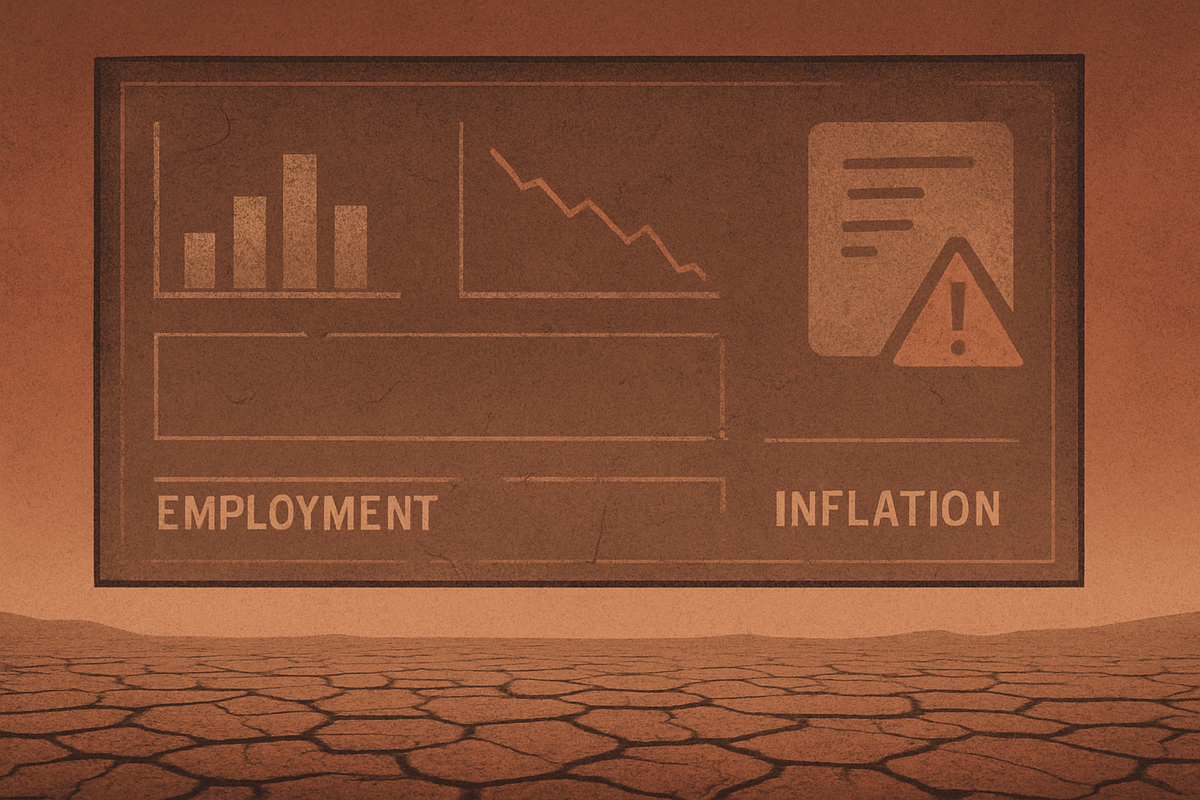
Washington D.C. – November 12, 2025 – Looking back from today, the critical period following a hypothetical, yet highly plausible, U.S. government shutdown in late 2024 served as a stark reminder of the indispensable role of timely economic data. As federal agencies grappled with reopening, the U.S. Labor Department faced immense pressure to prioritize the release of November employment and Consumer Price Index (CPI) data. This urgency stemmed from a prolonged "data blackout" that had left policymakers, businesses, and investors navigating an unprecedented fog of economic uncertainty.
The absence of these foundational economic indicators created a significant void, disrupting everything from Federal Reserve policy deliberations to corporate strategic planning. The incident underscored the fragility of an information-dependent economy when its primary statistical apparatus is brought to a halt, prompting widespread calls for more resilient data collection mechanisms.
The 2024 Shutdown: A Deep Dive into the Data Blackout
The hypothetical government shutdown, which commenced on October 1st, 2024, and extended until November 11th, plunged federal statistical agencies, most notably the Bureau of Labor Statistics (BLS) and the Bureau of Economic Analysis (BEA), into a state of suspended animation. Non-essential operations ceased, and a significant portion of the workforce was furloughed, effectively halting the collection and dissemination of vital economic statistics.
The timeline of events leading to the critical need for November's data unfolded with escalating concern. In early October, the immediate impact was the delay of the September jobs report. However, as the shutdown stretched into mid-October, the more severe implications became apparent: data collection for October's crucial reports, including the CPI (which relies on extensive in-person price collection) and detailed employment figures, was not occurring. By early November, the scheduled release dates for these October reports passed without any data, leaving a gaping hole in the economic picture. When the government hypothetically reopened on November 11th, 2024, the October data blackout was complete, shifting immediate attention to how quickly the Labor Department could provide the most current economic snapshot—that of November's activity.
Key players and stakeholders voiced profound concerns. The Federal Reserve, heavily reliant on "gold standard" data for monetary policy, found itself "flying blind" ahead of critical interest rate decisions. Economists across the public and private sectors scrambled for alternative, less reliable data sources, highlighting the risks of operating without comprehensive government statistics. Financial markets reacted with heightened volatility, as investors, traders, and analysts struggled to price assets and assess risk without clear signals on inflation and employment. The White House and Congress, responsible for resolving the impasse, also faced pressure to restore the flow of information, with some officials noting the potential for permanently lost data.
Corporate Fortunes in the Data Vacuum
A prolonged data blackout and the ensuing economic uncertainty had a disparate impact on public companies and various sectors, creating both "losers" and more resilient "winners."
Retailers and Consumer Discretionary Companies were among the hardest hit. Without timely retail sales data and consumer sentiment figures, companies like Walmart (NYSE: WMT), Target (NYSE: TGT), and Amazon (NASDAQ: AMZN) struggled to forecast demand, manage inventory, and plan marketing strategies, especially heading into the crucial holiday season. Similarly, the travel and leisure industry, represented by airlines such as Delta Air Lines (NYSE: DAL), faced reduced demand as consumer confidence waned amidst the uncertainty.
Federal Contractors and small businesses heavily reliant on government contracts experienced significant disruptions. Payment delays and the cessation of new contract awards created severe cash flow constraints, particularly for smaller vendors who often lack the financial reserves to weather such periods. The Housing Sector also felt the chill, as missing income verifications and general job insecurity deterred potential buyers, slowing sales and impacting related industries.
Conversely, certain sectors demonstrated greater resilience or even saw opportunities. Defensive Sectors, providing essential goods and services, often outperformed. Companies in Consumer Staples like Procter & Gamble (NYSE: PG) and Coca-Cola (NYSE: KO), as well as Healthcare firms such as Merck (NYSE: MRK), typically maintained stable demand. The Defense Sector, often funded through permanent appropriations and deemed essential for national security, remained relatively stable, with major contractors like Lockheed Martin (NYSE: LMT) and Raytheon Technologies (NYSE: RTX) largely insulated from the direct effects of the shutdown.
Perhaps the clearest "winner" during periods of extreme uncertainty was Gold Mining Companies. As investors flocked to safe-haven assets, firms like Newmont Corporation (NYSE: NEM) and Agnico Eagle Mines (NYSE: AEM) saw increased demand for the precious metal, often benefiting from rising gold prices. Companies with strong balance sheets and low debt were also better positioned to withstand economic shocks and even capitalize on opportunities arising from distressed competitors.
Wider Significance: A System Under Strain
The hypothetical 2024 data blackout underscored the profound and interconnected reliance of the modern economy on robust government statistics. This event was not merely a temporary inconvenience but a stark illustration of how disruptions to foundational data can trigger widespread ripple effects and expose systemic vulnerabilities.
In a world increasingly driven by data analytics, the absence of official employment and CPI figures highlighted the limitations of private sector alternatives. While private data providers attempted to fill the void, their offerings often lacked the comprehensive scope, methodological rigor, and broad acceptance of government statistics, leading to fragmented and potentially misleading economic assessments. This incident solidified a broader industry trend: the "gold standard" of government data remains irreplaceable for accurate macroeconomic analysis and forecasting.
The ripple effects extended beyond national borders. Global financial markets, heavily invested in the U.S. economy, experienced increased uncertainty, with international investors and central banks closely monitoring the situation. Businesses, both domestic and international, faced challenges in strategic planning, impacting supply chains and cross-border partnerships. Dealmaking also slowed, hampered by disrupted regulatory processes and uncertainty weighing on valuations.
From a policy perspective, the shutdown ignited renewed calls for mechanisms to insulate essential data collection from political impasses. Discussions emerged about potentially automatic funding for statistical agencies or formalizing protocols for the Federal Reserve to operate in data-scarce environments. The event also raised concerns about the long-term credibility of official statistics if prolonged data voids lead to permanent impairment or significant revisions. Historical precedents, such as the 2013 (16 days) and 2018-2019 (35 days) government shutdowns, offered glimpses into the economic drag and data disruptions, but the hypothetical 2024 scenario emphasized the risk of truly permanent data loss for critical monthly reports.
What Comes Next: Adapting to Uncertainty
The aftermath of such a data blackout necessitates both short-term recovery and long-term strategic adaptations for businesses and policymakers alike.
In the short term, the immediate priority was the restoration of data flow. While agencies worked to release backlogged reports, the quality of some data, particularly for October 2024, remained a concern due to missed collection periods. Businesses had to pivot quickly, relying more heavily on alternative data sources, internal metrics, and anecdotal evidence to guide decisions. Policymakers, especially the Federal Reserve, adopted a cautious stance, potentially delaying critical interest rate adjustments until a clearer economic picture emerged, embodying Chair Jerome Powell's sentiment of "slowing down" when driving in fog.
Longer term, the experience prompted a re-evaluation of data resilience. Businesses are now more likely to diversify their information streams, investing in their own data analytics capabilities and exploring partnerships with private providers as a hedge against future government data disruptions. For policymakers, the event could spur legislative efforts to safeguard essential statistical functions from future shutdowns, potentially through guaranteed funding or modified operating procedures. The long-term impact on data integrity, if some data was indeed permanently lost or severely compromised, could create lasting "blind spots" in historical economic time series, complicating future analysis and policy formulation.
Market opportunities or challenges also emerged. While initial uncertainty led to a "risk-off" sentiment, sectors like defensive industries and gold mining saw increased interest. Post-resolution, a "risk-on" momentum often returns, benefiting emerging markets and value stocks. However, the potential for repeated fiscal impasses continues to pose a systemic challenge, demanding greater adaptability and robust risk management from investors.
Comprehensive Wrap-up: Lessons from the Void
The hypothetical 2024 government shutdown and the subsequent scramble for November employment and CPI data served as a potent lesson in the critical importance of uninterrupted government functioning for economic stability. The key takeaway is clear: timely, accurate, and comprehensive government-produced economic data is not a luxury but a fundamental pillar supporting informed decision-making across all sectors of the economy.
The market's response, characterized by initial volatility and a flight to safety, eventually showed resilience post-resolution. However, the experience underscored how quickly uncertainty can erode confidence and impede efficient capital allocation. The lasting impact lies in the heightened awareness of data vulnerability and the ongoing debate about how to shield essential government functions from political gridlock.
For investors, the hypothetical 2024 event provides a roadmap for vigilance. In the coming months and years, it is crucial to watch for:
- Budget Negotiations and Debt Ceiling Debates: These perennial political flashpoints remain potential triggers for future data disruptions.
- Timeliness and Reliability of Data Releases: Any new delays or significant revisions in official statistics could signal ongoing underlying issues.
- Federal Reserve's Communication: Pay close attention to how the Fed discusses its data dependency and its strategies for navigating periods of informational scarcity.
- Growth of Alternative Data: While not a replacement, the increasing sophistication and adoption of private sector data sources can offer supplementary insights during periods of official data scarcity.
- Structural Reforms: Monitor any legislative efforts aimed at improving the budget process or ensuring the continuity of essential government services, including data collection.
The hypothetical data drought of 2024, though not a reality, offers invaluable insights into the profound implications of operating in an informational void. It stands as a compelling argument for safeguarding the integrity of the nation's statistical infrastructure, ensuring that policymakers, businesses, and investors are never again forced to navigate the economy "flying blind."
This content is intended for informational purposes only and is not financial advice





